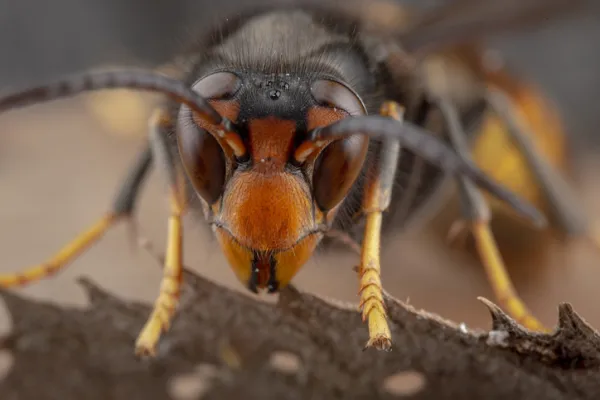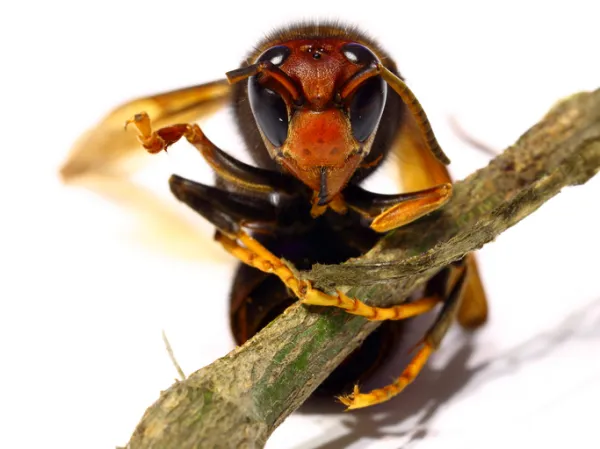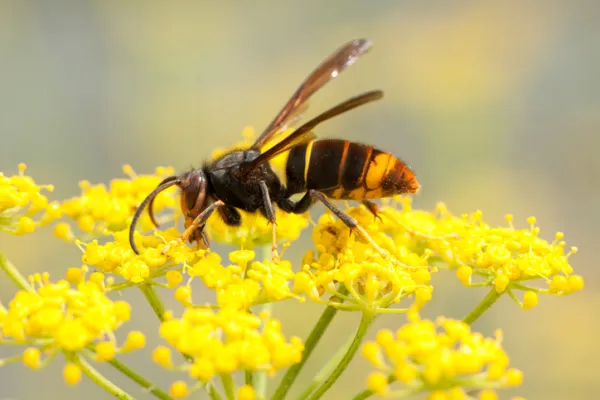In Europe, the Asian hornet (Vespa velutina), also known as the yellow-legged hornet or simply velutina, has become one of the most concerning invasive insect species. Over the past two decades, this large hornet has rapidly spread across coastal and humid climate areas, especially where rainfall is frequent and temperatures are mild. Due to its large population, aggressive behavior, and severe threat to honeybee colonies, it poses a triple threat to ecosystems, agriculture, and human health.

Compared to common wasps and honeybees, the Asian hornet has several distinctive traits:
Size
Workers measure 30–35 mm (3–3.5 cm) in length, significantly larger than the common wasp (about 20 mm) and the honeybee (about 15 mm).
Coloration
Head: Black or dark brown, with an orange-yellow face.
Thorax: Velvety dark brown to black.
Abdomen: A thin yellow band on the first segment; the fourth segment is bright yellow; the rest is mostly dark.
Legs: Yellow tips, visible even in flight.
Wings: Smoky brown and semi-transparent.
Behavior
Highly aggressive, especially when the nest is threatened.
Hunts honeybees intensively — each worker can capture 25–50 bees daily, devastating hives and harming beekeeping industries.

Asian hornets usually build their nests high in tree canopies, but in invaded areas, they also use unconventional sites such as:
Low shrubs
House eaves
Wall cavities
Abandoned tires, sheds, or garages
Nest features:
Size: Up to 0.8 m in diameter and 1 m tall
Material: A paper-like pulp made from chewed wood fibers mixed with saliva
Shape: Mostly spherical, sometimes pear-shaped
Internal design: Contains an insulating air layer to maintain stable temperature
Defensive behavior: Nests are heavily guarded; any nearby movement may trigger a mass attack

The venom of the Asian hornet is similar in composition to that of common wasps but is more dangerous due to:
Larger body size
Thicker stinger
Greater venom injection volume
High-risk groups:
People allergic to bee or wasp stings (about 3% of the population)
Elderly individuals
Those with cardiovascular or respiratory conditions
Victims of multiple stings
Severe reactions may include:
Anaphylactic shock: Swelling of the throat (laryngeal edema), difficulty breathing, and potential cardiac arrest
In extreme cases, death can occur within minutes without medical intervention
For most people:
Symptoms include intense pain, swelling, burning sensation
The affected area swells more and lasts longer than a common wasp sting

If the victim is high-risk (allergic, elderly, with underlying conditions):
Call emergency services immediately
Medical staff may administer adrenaline (epinephrine), antihistamines, or corticosteroids
For non-allergic individuals:
Move away from the nest area immediately to avoid further stings
Rinse the sting site with plenty of clean water
Apply a cold compress to reduce swelling and pain
Avoid applying soil, herbs, or unsterilized remedies, as they can cause infection
There are no effective chemical repellents specifically for Asian hornets. The most practical approach is trapping:
DIY trap method:
Use a container (bucket, large bottle, or jug)
Add a sweet liquid bait (honey water, sugar water, or sugar + beer + yeast mixture)
Add a small amount of alcohol to deter bees
Place traps near known hornet activity areas
Natural predators include:
European honey buzzard (Pernis apivorus)
Bee-eater bird (Merops apiaster)
European badger (Meles meles)
While these predators help control populations in the wild, human intervention is necessary in urban or agricultural zones.
The invasion of the Asian hornet threatens bee populations, agricultural productivity, and human safety. Recognizing its characteristics, behavior, and control methods is the first step in reducing risks. Combating this invasive species requires both scientific management and ecological balance protection.
Bibliography
Zafra, A. (07/24/2018) Homegrown R&D, key to fighting the Asian hornet plague. EFE Agency: Biodiversity.
Gamarra, L. (2016) Regulation of the Asian hornet within the framework of invasive alien species. Monfragüe Scientific Journal: Resilient Development. Volume VII(2), pp: 178-186.
EFE Verde Editorial Team (03/06/2019) The European honey buzzard, a natural support against the Asian hornet. EFE Agency: Biodiversity.
EFE Verde Editorial Team (07/13/2016) The Asian hornet, included in the EU list of invasive species. EFE Agency: Biodiversity.
animal tags: asian hornet
We created this article in conjunction with AI technology, then made sure it was fact-checked and edited by a Animals Top editor.